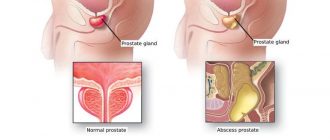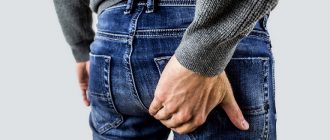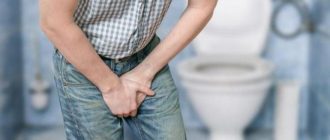Pain in the testicles with prostatitis occurs with many pathologies of the male genitourinary system. If you have such a symptom, you should not postpone a visit to the urologist, because this can lead to the development of the disease and the occurrence of many complications. Treatment is most often carried out using conservative methods, and only in later stages requires surgical intervention.
Causes
With prostatitis, the testicles hurt due to the fact that this organ is connected by nerve endings to all other organs of the genitourinary system, but there are no nerves in the prostate gland itself. Therefore, in case of any pathologies, pain can radiate and be felt by other organs. Most often, in addition to the testicles, pain occurs in the following places:
- groin area and pubis;
- hypogastrium;
- lumbosacral back;
- buttocks and anal area.
In addition, with prostatitis, it is possible that the left or right testicle hurts, and not both at the same time.
This symptom can be caused not only by inflammation of the prostate gland, but also accompany other disorders, so when it appears, it is very important to undergo an examination as soon as possible and make an accurate diagnosis. The following pathologies are possible:
- Sexually transmitted infectious diseases.
- Testicular torsion.
- Benign hyperplasia (adenoma).
- Malignant tumor (cancer).
- Mechanical injuries of the perineum.
- Orchitis (can be a complication of prostatitis in the absence or ineffectiveness of therapy).
- Epididymitis (inflammation of the seminal appendages).
- Varicocele.
- Cysts.
In addition to the above reasons, the symptom may be due to orchiepididymitis. In this case, it appears only after surgery, if it was carried out in violation of sanitary conditions and the organ became infected with microorganisms.
If the testicles hurt after prostate massage, this is evidence of ineffective treatment. It is worth informing the treating urologist about this, after which the approach to therapy will be revised - additional medications may be prescribed or massage procedures may be discontinued.
Features of the symptom
Pain in different forms of prostatitis is also felt differently.
A characteristic sign of acute inflammation of the prostate gland can be the fact that with prostatitis the right testicle begins to hurt, it also swells and rises 2-3 cm higher than the left one. The pain is sharp, often felt like a pulsation, 6-7 times a day, and occurs spontaneously.
With chronic prostatitis, the testicles most often swell, the pain is more prolonged, feels like an aching or pulling in both parts of the organ at once, can be felt in the entire scrotum at once and radiate to the pubis or groin. Most often occurs after urination, defecation, or at the end of sexual intercourse.
Pain in the testicles in men with prostatitis signals the progress of the disease and may be the first evidence of a complication such as orchitis (inflammation of the testicles). With further absence or ineffective therapy, the situation will be complicated by new manifestations and complications.
Diagnostics
If there is no clearly diagnosed disease, but a similar symptom is observed, a thorough examination is required to identify the pathology and begin treatment. The fact is that such a symptom can be caused by a fairly wide range of diseases, and to eliminate it, it is necessary to cure the cause of its appearance. The remaining possible symptoms also do not indicate a specific cause, because they are characteristic of most pathologies of the pelvic organs.
First of all, an examination and history taking is carried out by a urologist; a visual examination of the scrotum and genital organ, as well as palpation of the prostate, can immediately be carried out. Further laboratory and instrumental examinations include:
- general blood and urine tests;
- PSA blood test;
- Ultrasound, TRUS, CT or MRI of the pelvic organs;
- spermogram;
- urethral smear (to detect sexually transmitted infections);
- microscopy and bacterial culture of prostatic secretions (needed to determine the causative agent of infection and the effect of various groups of antibiotics on it);
- biopsy.
During diagnostic examinations, it is recommended to refrain from taking painkillers, as this may lead to an incorrect diagnosis.
Treatment
Therapy is carried out after an accurate diagnosis and is aimed at eliminating the cause of the symptom. In most cases, a wide range of medications are prescribed:
- antibiotics;
- anesthetics;
- alpha-blockers;
- anti-inflammatory.
In addition to medications, physiotherapeutic procedures are prescribed. This is especially effective if the inflammation is not caused by bacteria, but as a result of stagnation.
In rare cases, if the disease is advanced or in late stages, surgical intervention may be prescribed, including removal of the affected organ.



